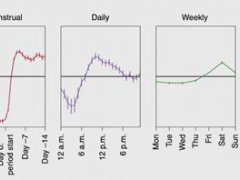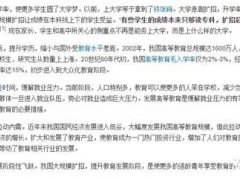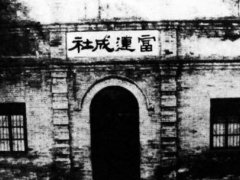新科学发现 耶稣曾对胞弟提到 地球是一座监狱 (机翻)
耶稣的秘密启示?埃及发现的违禁教诲副本

来自埃及开罗科普特博物馆的科普特人对雅各布的第一次启示录的翻译。
(图片:)纳格哈马迪图书馆/牛津大学)
一本声称是耶稣对他哥哥詹姆斯的教诲的经文的最古老的副本在一个古埃及的垃圾堆里被发现,这些垃圾堆散落在五世纪的纸莎草堆、古代的税单和货车和驴子的销售单据中。
据一份声明称,这份手稿是一个罕见的希腊语版本,它是一个被称为《詹姆士第一启示录》的虚构的新约故事,直到现在,人们还认为它只保存在科普特语(一种从象形文字演变而来的埃及本土语言)中。德克萨斯大学奥斯汀分校的宗教研究讲师布伦特兰道(Brent Landau)说,这篇文章很可能是在五、六世纪写成的,他与奥斯汀大学的宗教研究学者杰弗里史密斯(Geoffrey Smith)一起在11月波士顿举行的圣经文学学会年会上介绍了这一发现。调查结果尚未接受同行审查。
这一发现属于英国牛津大学(Oxford University)收藏的20多万份纸莎草纸文献的收藏,最早是在19世纪末从埃及奥克西恩库斯(Oxyrhynchus)镇的垃圾堆中挖掘出来的。今年夏天早些时候,史密斯和兰道从六种不同的纸莎草碎片中拼凑出了这份文件。两人已经研究氧同步的发现两年多了。
罕见的发现
兰道说,这份手稿之所以重要,有几个原因。
首先,他说,这是用希腊语写的。
兰道在接受《生活科学》杂志采访时说:“希腊语是基督教原始著作最早使用的语言,因为它是当时罗马帝国的通用语言。”在希腊语中发现(伪经文本)是极其罕见的——它绝对是原始语言。”
这意味着,虽然这不是第一本雅各布的启示录,但它可能是最古老的。另一个已知的版本是在纳格哈马迪图书馆发现的,这是1945年在埃及发掘的13本科普特诺斯替书籍的集合。公元367年,亚历山大主教亚他那修斯(Athanasius)将27本书的正典定义为《新约全书》(New Testament),此后不久,纳格·哈马迪(Nag Hammadi)的书很可能被藏起来保存。所有其他的故事,像那些在纳格哈马迪收藏,被认为是异端。
考虑到手稿的禁书状态,另一个令人惊讶的方面是,它似乎是一个教学版。
兰道说:“几乎所有的音节都是用这些中间的小点来划分的,这些中间的小点就在线的中间。”。
当时的手稿通常是用流畅、连续的文字写成的。看到如此清晰的音节划分,这表明这本书是老师的工具,帮助学生学习如何用希腊语读写。
兰道说:“当这本书在五、六世纪被人的学校使用时,这本书实际上已经被禁止了。”很明显,这个教官,不管他或她是谁,都很喜欢詹姆斯的第一个启示录。”
被禁止的文本
兰道说,像《詹姆士第一启示录》这样的诺斯底派经文很可能被禁止,因为它们对耶稣的重要性有“不同的理解”。
兰道说:“他们更了解耶稣,因为他是人类智慧的展示者,而不是弥赛亚。”根据这些诺斯底的经文,耶稣教导人们,物质世界实际上是一个被邪恶的上帝囚禁的监狱——本质上很像电影《黑客帝国》
在雅各布的第一个启示录中,耶稣向他的兄弟描述了这个监狱。他揭示说,这个世界由被称为执政官的恶魔守护着,他们正在阻挡物质世界和来世之间的道路。”兰道说:“雅各布死后需要通过密码——有点像电子游戏中的作弊代码。”。
“你可以看到这是多么反文化。”
兰道和史密斯目前正致力于将他们的发现发表在即将出版的“红喙斑疹病”系列中,这是一个正在进行的红喙斑疹病发现目录,首次发表于120年前。
最初发表在《生命科学》杂志上。
Jesus Secret Revelations? Copy of Forbidden Teachings Found in Egypt
By Brandon Specktor December 04, 2017

Jesus Secret Revelations? Copy of Forbidden Teachings Found in Egypt
The oldest known copy of a text claiming to be Jesus teachings to his brother James has been discovered in an ancient Egyptian trash dump, scattered among piles of fifth-century papyrus, ancient tax receipts and bills of sale for wagons and donkeys.
The manuscript is a rare, Greek-language edition of an apocryphal New Testament story called The First Apocalypse of James, that, until now, was thought to only be preserved in the Coptic language (an indigenous Egyptian language evolved from hieroglyphics), according to a statement. The text was likely written in the fifth or sixth century, said Brent Landau, a religious studies lecturer at the University of Texas at Austin, who presented the findings along with Geoffrey Smith, a religious studies scholar at UT Austin, at the Society of Biblical Literature Annual Meeting in Boston in November. The findings have not yet been subject to peer review.
The find belongs to a collection of more than 200,000 papyrus documents housed at Oxford University in England, first excavated from a rubbish heap in the Egyptian town of Oxyrhynchus in the late 19th century. Smith and Landau pieced together the document from six different papyrus fragments in the collection earlier this summer. The two had been studying the Oxyrhynchusfindings for more than two years. [Religious Mysteries: 8 Alleged Relics of Jesus]
A rare find
The manuscript is significant for a few reasons, Landau said.
For one, he said, its written in Greek.
Greek was the earliest language that the original Christian writings were composed in because it was sort of the universal language of the Roman empire at that time, Landau told Live Science. Its extremely rare to find [apocryphal texts] in Greek — it was definitely the original language.
That means while this is not the first copy of the First Apocalypse of James ever found, it is likely the oldest. The only other known version of the text was discovered in the Nag Hammadi library — a collection of 13 Coptic Gnostic books excavated in Egypt in 1945. Buried in jars underground, the Nag Hammadi books were likely hidden for safekeeping sometime after A.D. 367 when Athanasius, the bishop of Alexandria, defined the canon of 27 books known today as the New Testament. All other stories, like those found in the Nag Hammadi collection, were deemed heretical.
Considering the manuscripts forbidden status, another surprising aspect is that it appears to be a teaching edition.
Nearly all of the syllables are p>
Manuscripts of the time were often written in a fluid, continuous script. To see syllables so clearly p>
By the time this text would have been used in somebodys school in the fifth or sixth century, this text was effectively banned, Landau said. So clearly, this instructor, whoever he or she was, was quite fond of The First Apocalypse of James.
Forbidden text
Gnostic texts like The First Apocalypse of James were likely banned because of their different understanding of what Jesus importance was, Landau said.
They understood Jesus much more in terms of being a revealer of human wisdom than as a messiah, Landau said. According to these Gnostic texts, Jesus taught people that the material world was actually a prison crated by an evil god — a lot like the movie The Matrix, essentially.
In The First Apocalypse of James, Jesus describes this prison to his brother. He reveals that the world is guarded by demonic figures called archons, who are blocking the path between the material world and the afterlife. What James needs to get by them when he dies are passwords — sort of like cheat codes in a video game, Landau said.
You can see how this is pretty counter-cultural.
Landau and Smith are currently working to publish their findings in an upcoming series of the Oxyrhynchus Papyri, an ongoing catalog of the Oxyrhynchus discovery first published 120 years ago.
Originally published on Live Science.
来源:
(新科学发现 耶稣曾对胞弟提到 地球是一座监狱 (机翻))宝,都看到这里了你确定不收藏一下??





